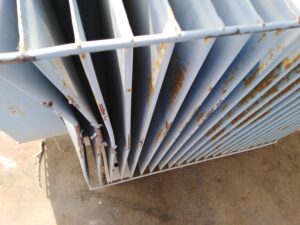Table of Contents
common types of faults in transformers
Transformers are essential components in electrical systems, but they can develop faults due to various factors such as aging, overload, insulation failure, and environmental conditions. Here are the seven most common transformer faults and issues:
1. Overheating
- Caused by overloading, poor ventilation, high ambient temperatures, or insulation degradation.
- Leads to insulation breakdown, reducing transformer lifespan.
- Preventive measures: Proper load management, cooling system maintenance, and regular temperature monitoring.
2. Insulation Failure
- Due to thermal aging, moisture ingress, or electrical stress.
- Results in short circuits, arcing, and transformer breakdown.
- Preventive measures: Periodic insulation testing, oil analysis, and moisture control.
3. Oil Contamination and Leakage (in Oil-Filled Transformers)
- Oil degradation due to oxidation, moisture, or dirt reduces insulation quality.
- Leaks from gaskets or tank damage can lead to low oil levels, overheating, and dielectric failure.
- Preventive measures: Regular oil testing, leak detection, and timely oil filtration/replacement.
4. Winding Deformation or Damage
- Mechanical stress from short circuits, inrush currents, or aging weakens windings.
- Leads to increased losses, insulation failure, or even catastrophic failure.
- Preventive measures: Protection system calibration, short-circuit withstand analysis and routine testing.
5. Bushings Failure
- Cracks, dirt accumulation, or moisture ingress can cause flashovers or insulation breakdown.
- Faulty bushings can lead to external arcing and transformer failure.
- Preventive measures: Regular cleaning, infrared thermography, and dielectric testing.
6. Tap Changer Malfunction
- Occurs due to poor contact, wear, or contamination in On-Load Tap Changers (OLTC).
- Leads to voltage fluctuations, arcing, and contact burning.
- Preventive measures: Regular maintenance, contact resistance measurement, and oil analysis for OLTC.
7. Core and Coil Issues
- Core lamination faults, loosened clamps, or shorted turns cause excessive vibrations, humming, and eddy current losses.
- Can lead to overheating and increased energy losses.
- Preventive measures: Vibration analysis, thermographic inspection, and tightening core bolts.

Common Symptoms of Transformer Failure
Detecting transformer failure early can prevent catastrophic damage and costly downtime. Here are the most common symptoms of transformer failure:
1. Overheating
- Symptoms: Excessive temperature rise, hot oil smell, and tripping of temperature relays.
- Causes: Overloading, poor ventilation, cooling system failure, or insulation degradation.
2. Unusual Noises (Humming, Buzzing, or Clicking Sounds)
- Symptoms: Louder-than-normal humming, irregular buzzing, or clicking sounds.
- Causes: Loose core laminations, mechanical stress, winding deformation, or electrical faults.
3. Oil Leaks (in Oil-Filled Transformers)
- Symptoms: Oil stains around gaskets, valves, or bushings; low oil level in the conservator.
- Causes: Gasket aging, physical damage, or thermal expansion issues.
4. Discolored or Deteriorated Oil
- Symptoms: Dark, cloudy, or burnt-smelling oil, often detected in oil testing.
- Causes: Overheating, moisture contamination, or oxidation leading to insulation breakdown.
5. Frequent Tripping of Protective Relays
- Symptoms: Unexpected tripping of Buchholz relay, temperature relays, or differential protection.
- Causes: Internal faults, overheating, short circuits, or winding failure.
6. Voltage Fluctuations or Power Quality Issues
- Symptoms: Unstable output voltage, flickering lights, or equipment malfunction.
- Causes: Tap changer failure, loose connections, or winding damage.
7. Partial Discharges (Indicating Insulation Weakness)
- Symptoms: Detection of electrical discharges through diagnostic testing or unusual crackling sounds.
- Causes: Insulation degradation, moisture ingress, or winding defects.
8. Burning Smell or Smoke
- Symptoms: Strong burnt odor, visible smoke, or scorching marks on the transformer.
- Causes: Internal short circuits, insulation failure, or excessive overheating.
9. Deformation of Bushings or External Components
- Symptoms: Cracked, swollen, or discolored bushings.
- Causes: Overvoltage, lightning strikes, contamination, or mechanical stress.
10. Reduced Efficiency and Power Losses
- Symptoms: Higher-than-normal energy losses, increased heat, and reduced output power.
- Causes: Aging, core saturation, winding degradation, or improper loading.
Preventive Measures
- Regular oil analysis (DGA – Dissolved Gas Analysis)
- Infrared thermography to detect overheating
- Protective relay testing for early fault detection
- Load monitoring to prevent overloading
- Routine insulation resistance tests
Preventive Measures for Transformer Failure
Preventive maintenance helps extend the lifespan of transformers, ensuring safe and efficient operation while minimizing unexpected failures. Below are key preventive measures to detect and prevent transformer issues before they escalate:
1. Regular Oil Analysis (For Oil-Filled Transformers)
Why? Transformer oil acts as both an insulator and a coolant. Over time, it can degrade due to oxidation, moisture, and contamination.
How?
- Dissolved Gas Analysis (DGA): Identifies gases (like hydrogen, methane, ethylene) formed due to overheating, arcing, or insulation breakdown.
- Moisture Content Testing: Ensures insulation integrity, as water reduces dielectric strength.
- Acidity & Dielectric Strength Test: Determines oil quality and if replacement or filtration is needed.
2. Infrared Thermography (Thermal Scanning)
Why? Helps detect hot spots caused by loose connections, unbalanced loads, or insulation failure.
How?
- Thermal cameras are used to scan transformers and reveal abnormal temperature variations.
- Hotspots indicate potential failure points that require immediate maintenance.
3. Routine Insulation Resistance Tests
Why? Ensures insulation health, preventing short circuits or dielectric failures.
How?
- Megger Testing: Measures insulation resistance between windings and the core.
- Polarization Index (PI): Evaluates insulation degradation over time.
- Capacitance and Dissipation Factor Tests: Detect insulation contamination or moisture.
4. Load Monitoring & Proper Loading
Why? Overloading causes overheating, reduces efficiency, and shortens transformer life.
How?
- Install load monitoring systems to track power consumption and prevent overloading.
- Ensure loads are evenly distributed across all phases.
- Use Automatic Tap Changer (ATC) systems to maintain stable voltage levels.
5. Protective Relay Testing & Calibration
Why? Protects against faults like overcurrent, earth faults, and differential protection failures.
How?
- Test and calibrate Buchholz relays, overcurrent relays, and differential protection relays.
- Ensure that relays are triggering correctly under fault conditions.
- Check for false tripping or delayed response issues.
6. Periodic Visual & Physical Inspections
Why? Identifies early signs of wear, leaks, or physical damage.
How?
- Inspect for oil leaks, rust, damaged bushings, and loose connections.
- Check cooling fans, radiators, and breather condition (silica gel color change).
- Verify the tightness of bolts and connections to prevent overheating.
Read also my detailed article Hidden Dangers: Transformer Oil Loss Hazards.
7. Bushing & Tap Changer Maintenance
Why? Faulty bushings or tap changers can cause voltage instability and insulation failure.
How?
- Clean and test bushings for cracks or moisture ingress.
- Inspect On-Load Tap Changers (OLTCs) for wear, carbon deposits, and contact burning.
- Perform contact resistance tests to ensure smooth tap changer operation.
8. Grounding System Checks
Why? Proper grounding prevents voltage surges, lightning damage, and static charge buildup.
How?
- Regularly measure ground resistance using an earth tester.
- Ensure neutral grounding resistors (NGRs) are in good condition.
- Maintain lightning arresters to protect against voltage spikes.
9. Cooling System Maintenance
Why? Overheating is a leading cause of transformer failure.
How?
- Check oil levels in conservator tanks for proper cooling.
- Clean radiators and cooling fans to ensure efficient heat dissipation.
- Verify cooling system alarms and temperature sensors are functioning correctly.
10. Proper Storage & Environmental Protection
Why? Environmental factors like moisture, dust, and extreme temperatures can degrade transformer components.
How?
- Store transformers in a dry, temperature-controlled area when not in use.
- Use protective coatings to prevent rust and corrosion.
- Implement humidity control systems to reduce moisture absorption.
Conclusion
By following these preventive measures, you can significantly extend transformer lifespan, reduce failure risks, and improve reliability. Regular testing, monitoring, and maintenance are key to ensuring safe operation.
Don’t Leave Empty-Handed!
Install my Free Android App on Google Play:
Electrical Cables Most Common Tables “Cables Tables”
And, my Electrical Calculations App “Fast Electrical Calculator”
Discover more great content by subscribing to My channel
Looking to stay ahead of the game in the world of electrical engineering? Subscribe to my YouTube channel and gain access to exclusive content you won’t find anywhere else!
The staff I recommend
(Amazon Affiliate Links to products I believe are high quality):
- Economy 120 Volt/60Hz AC Power Source – Step-Down Voltage & Frequency Converters 1800W
- UNI-T Digital Multimeter Tester UT139C
- 50-Amp Extension Cord for RV “100ft”
- Voltage Stabilizer 110/220v
- Hair Dryer “best selling“
- TOSHIBA EM131A5C-BS Countertop Microwave Ovens
Disclaimer: This contains affiliate links to Amazon products. I may earn a commission for purchases made through these links.


